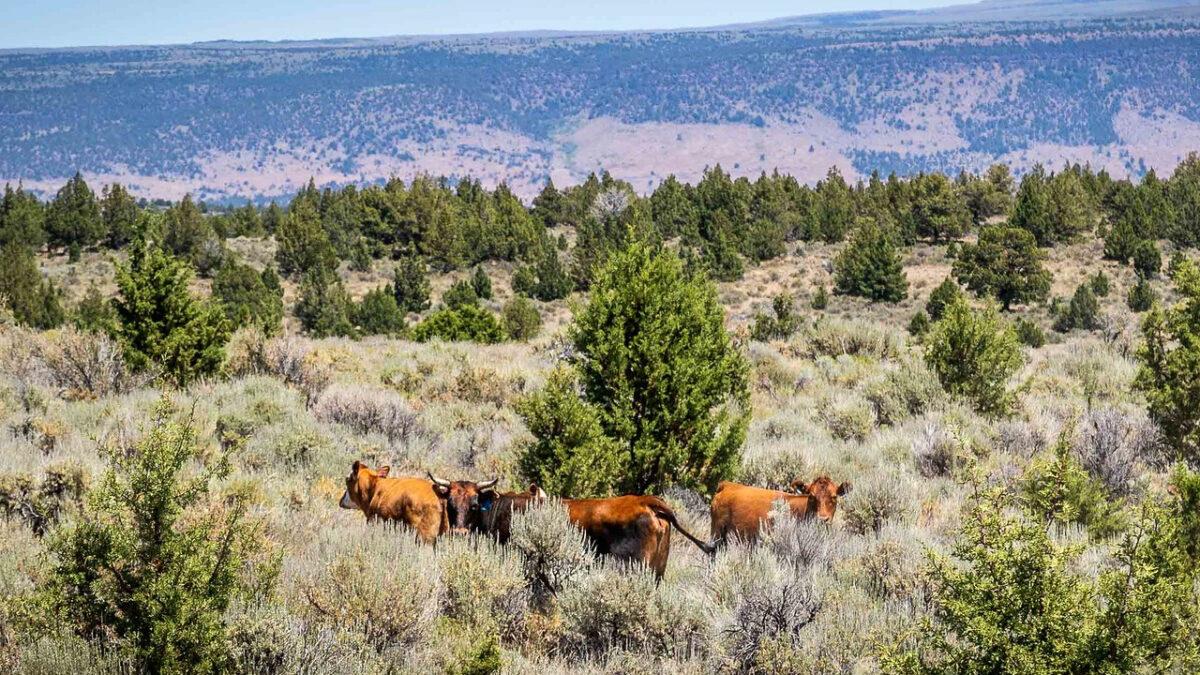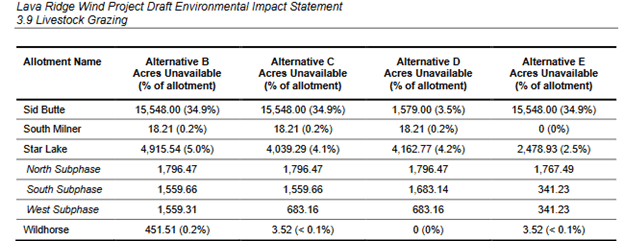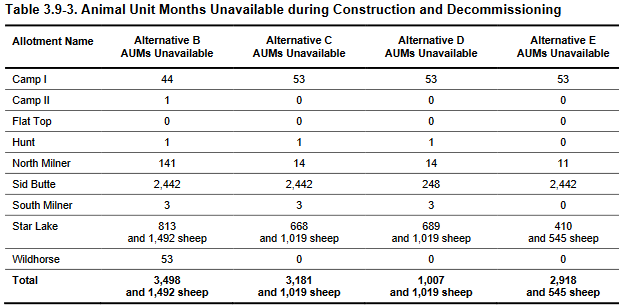Grazing Coordination Plan
This is long, but more importantly, the need to get the information out exceeds the length of the article.
In Part 1, the Draft Environmental Impact Statement (DEIS) for the Lava Ridge Wind Project was reviewed for potential violations by the Bureau of Land Management (BLM) regarding grazing laws. Contained within the DEIS documents is the Draft Appendix S: Grazing Coordination Plan (GCP), which details how much impact, and disruption, would occur to the cattle industry. Questions about federal grazing laws being violated by the BLM continue with the GCP.
The GCP was developed by Magic Valley Energy (MVE), a front name for LS Power. Although not identified in the GCP, it is known that Jack Alexander, founder of Synergy Resource Solutions, was involved in the creation of this document. Why the secrecy MVE?
Synergy Resource Solutions has some interesting connections. Mr. Alexander is a past president of the Society for Range Management, which supports the United Nations International Year of Rangelands. As a Certified Professional in Erosion and Sediment Control, International Erosion Control Association (IECA), he has some connections to the corporate world.
While Mr. Alexander has many degrees, it is unclear how much time he has spent on a range herding cattle. It appears MVE engaged this person, or business, for the purposes of creating a grazing plan that suspiciously buys opinions on what LS Power wants, or needs, to build its project. There is no investment in the cattle, the ranchers, or what is ethically right. Apparently, LS Power thinks it is no big deal to shuffle cattle around while having the ranchers do the work. Ask any rancher how difficult it is to herd cattle to a new area for food and water, it isn’t that easy.
In Appendix S, page S-1 of the GCP, it states “MVE is committed to working with the local grazing permittees (ranchers)”, yet the plan does not appear to have been developed with those ranchers. If MVE’s “objective has been and will continue to be close coordination with the grazing permittees”, then why do ranchers oppose this project?
In MVE’s FAQ, “What happens to the grazing/ranching operations during construction and once the project is in operation?” And the provided answer, “The range improvements installed by MVE will benefit the long-term management of the grazing allotments.” There doesn’t appear to be any range improvements in the GCP that will benefit grazing allotments now or in the long term. In fact, as stated in the DEIS, page 3-285, “BLM grazing allotments (the land permitted to be used for grazing) would be subject to long-term reductions in allotment acreage…some areas could remain permanently unavailable”. Also on page 3-278, the project involves “altering forage conditions, altering the forage availability for livestock grazing, and altering existing range improvements.” This clearly describes alterations that will result in reductions and/or permanent removal, not improvements.
Page S-1 also states grazing permittees identified impacts from this project as the death of cattle, activities affecting range improvements, reduced permittee AUM, and livestock health being affected. Yet, the stated GCP purpose is to outline “how the Project will coexist with the grazing operations”. Coexisting is an interesting term, as its perception of coexistence is really about shuffling cattle around at the convenience of project needs, disrupting the lives of cattle ranchers, placing the burden on them to do the work, and destroying productive use of the land for years.
Page S-3 – “temporary fencing” will create “isolated “sub-pastures” and “gaps for access to water” that will be solved by bringing in up to 50 water troughs for the cattle. The expectation for ranchers herding cattle to these areas will be an ongoing burden, and it is doubtful cattle will have a positive response to their water source being moved.
Plus, 40 CFR 1508.27(b)(7) states, “Significance cannot be avoided by terming an action temporary or by breaking it down into small component parts.” With the ongoing construction and removal of temporary fencing, creating small areas of disruption one at a time, the overall significant impact of these mitigation measures cannot be lessened.
“For AUMs (the amount of forage needed for one cow over one month) that are unavailable during the construction and reclamation periods, MVE is committed to providing an equivalent feed source to affected grazing permittees. This may take the form of range forage at other locations, private ground forage operations, feedlot space, or other commercial arrangements that MVE may agree to” with ranchers (page S-3). This is more disruption and burden for the rancher. Is this just during construction, or is it also during decommissioning? Is this provision of feed an attempt to buy off ranchers?
This is also not good for the cattle, changing a cow’s diet can produce problems. “Cattle are creatures of habit and disruptions in their routine can lead to disruptions in feed intake” (pages 2-3 Bunk Management). This is just one reason the ranchers are concerned about the cattle’s health.
Listed on pages S-3 through S-10 is the impact on those allotments. There is also the plan to have the cattle share their range with sheep (page S-5-6), but putting cattle with sheep can be more complicated because of the differences in grazing habits. Are sheep ranchers okay with this? Do grazing permits include provisions for sheep?
Two “preferred” alternatives have been chosen by the BLM, C and E. Below is a graph of the percentage of allotment that would be unavailable in Alternatives C and E (page 3-280). Maps showing how allotments would be affected in the alternatives are on page 3-275 in the DEIS.
On the same page this chart shows the number of AUMs that would be unavailable in Alternative C and E.
The DEIS has other charts showing the percentages of loss from 3-277 to 3-285, and even references “when Combined with Other Reasonably Foreseeable Renewable Energy Projects.” Yes, the BLM has already mapped out its plan for massive areas of Idaho to be degraded. Pages S-9 through S-10 have charts on the number of AUMs affected on just one allotment.
There are laws that protect grazing and the public.
43 CFR § 4100.0-2 – to establish efficient and effective administration of grazing of public rangelands; and to provide for the sustainability of the western livestock industry and communities that are dependent upon productive, healthy public rangelands. (b) These objectives will be realized in a manner consistent with land use plans, multiple use, sustained yield, environmental values, economic and other objectives stated in the Taylor Grazing Act of June 28, 1934, as amended (43 U.S.C. 315, 315a);
43 U.S. Code § 1701 – “The Congress declares that it is the policy of the United States that, the public lands be managed in a manner that will protect the quality of…scenic, historical, ecological, environmental…values…will preserve and protect certain public lands in their natural condition; that will provide food and habitat for…domestic animals; and that will provide for outdoor recreation and human occupancy and use (a8); the public lands be managed in a manner which recognizes the Nation’s need for domestic sources of…food…from the public lands (a12).” Not only are those qualities not protected in this project, but outdoor recreation is also affected.
The Public Rangelands Improvement Act of 1978 (43 U.S.C. 1901(b)(2)) requires rangelands are managed and improved to be as productive as possible. The Lava Ridge project does neither. It doesn’t appear that ranchers were given opportunity to participate in any plan formulation for grazing (f). Rather, a consulting firm appears to have been paid by MVE to develop the plan, in its favor.
43 CFR § 4130.2(e)(1) – “The lands for which the permit or lease is issued remain available for domestic livestock grazing”. Clearly, the land will not be available for grazing with temporary fencing that results in allotment reductions and eventual permanent damage.
Section 102 of the Federal Land Policy and Management Act of 1976 (43 U.S.C. 1701) (FLPMA) states, “(7) goals and objectives be established by law as guidelines for public land use planning, and that management be on the basis of multiple use and sustained yield (MUSY) unless otherwise specified by law”. Not only does the project itself violate multiple use principles, but by intersecting allotments and reducing AUMs, sustained yield by the cattle industry cannot be achieved. The Lava Ridge project falls under the mandates of FLPMA and the National Environmental Policy Act (NEPA) (16 U.S. Code § 824p(h)(6)(D)(iv)(v)).
43 USE 1712(c)(9) – “(9) to the extent consistent with the laws governing the administration of the public lands, coordinate the land use inventory, planning, and management activities of or for such lands with the land use planning and management programs of other Federal departments and agencies and of the States and local governments within which the lands are located, assist in resolving, to the extent practical, inconsistencies between Federal and non-Federal Government plans, and shall provide for meaningful public involvement of State and local government officials, both elected and appointed, in the development of land use programs, land use regulations, and land use decisions for public lands, including early public notice of proposed decisions which may have a significant impact on non-Federal lands. Land use plans of the Secretary under this section shall be consistent with State and local plans to the maximum extent he finds consistent with Federal law and the purposes of this Act.”
The BLM failed to initiate Coordination (42 U.S.C. 4331(b)), so it is up to the affected counties to start this process. The BLM is required to follow both the NEPA (42 U.S.C. 4331(b)), and the FLPMA (43 U.S. Code § 1712(9)) mandates for Coordination.
Coordination is defined “as a government-to-government communication process, seeking consistency, in which local government has an equal negotiating position with the federal agencies. This government-to-government communication negotiating process allows local government to participate on an equal basis in all phases of planning and management of land, water and wildlife resources. Such consistency will allow local governments to once again protect the local tax base, sustain a viable and stable local economy, and protect the public health and safety. Clear direction exists for local governments to use coordination to fairly represent citizens in bringing back local control from runaway big governments.” Coordination is NOT consulting, collaborating, or cooperating with local governments, nor is it a “subcommittee” that is nothing more than a spectacle of collaboration to placate and divert from the legal mandate to Coordinate.
40 CFR 1508.7 states, “Cumulative impact is the impact on the environment which results from the incremental impact of the action when added to other past, present, and reasonably foreseeable future actions regardless of what agency (Federal or non-Federal) or person undertakes such other actions. Cumulative impacts can result from individually minor but collectively significant actions taking place over a period of time.” With the current and stated future solar and wind projects by BLM, there will be massive, collectively significant, and cumulative impacts on Idaho land, including the ongoing temporary fencing disruptions.
There is also CFR 43 4110.4-2(b) that states “when BLM land is devoted to a public purpose”, in this case wind turbines, livestock grazing is precluded from any decrease in land acreage, which invalidates the GCP as it is written.
In 2005, the BLM developed the Wind Energy Development Program. This required the BLM to create a Programmatic Environmental Impact Statement (PEIS) that evaluated potential land use impacts from wind projects. In its Record of Decision (ROD), there are protections for the cattle industry.
“The BLM will not issue ROW (right of way) authorizations for wind energy development on lands on which wind energy development is incompatible with specific resource values…Additional areas of land may be excluded from wind energy development on the basis of findings of resource impacts that cannot be mitigated and/or conflict with existing and planned multiple-use activities or land use plans. To the extent possible, wind energy projects shall be developed in a manner that will not prevent other land uses, including…livestock grazing, recreational use, and other ROW uses” (page A-2).
In the BLM Mitigation Handbook, it states the BLM might deny a project if the action would violate a law, or not conform to a land use plan. Or it can be denied if there are “legal, regulatory, land use plan, or policy protections that limit or prevent certain types of impacts” even after mitigation, or “result in unnecessary or undue degradation” to the land (FLPMA § 302(b), 43 USC § 1732(b)) (page 2-15). There is strong evidence that this project qualifies for a denial decision.
According to its own Wind Energy Program Policies and Best Management Practices (BMPS), BLM wind energy projects “shall be developed in a manner that will not prevent other land uses, including minerals extraction, livestock grazing, recreational use, and other ROW uses (1-1).” Removal of allotments and AUMs prevents land use, along with recreational use, for years.
Has the BLM adequately addressed all grazing laws or complied with them? It is time to challenge the BLM on these laws, and encourage county commissioners to invoke Coordination. Much opposition exists, this project is not wanted anywhere in Idaho. For Idahoans who live outside the area, help Magic Valley with this opposition, challenge the BLM on these laws, and if there is data opposing BLM data, send it in. No Idahoan is safe from this energy transition agenda.
Comments can be submitted here, just click on the green “Participate Now” button on the left, or comments can be emailed to BLM_ID_LavaRidge@blm.gov. Tell the BLM that the proposed mitigation measures for cattle are unacceptable and appear to violate federal law. The only option is to deny this project and select Alternative A, No Action (page 2-1).




